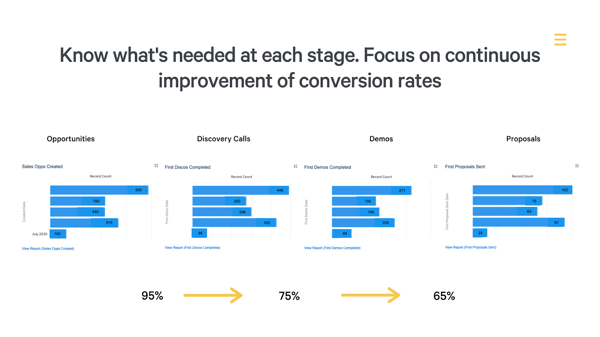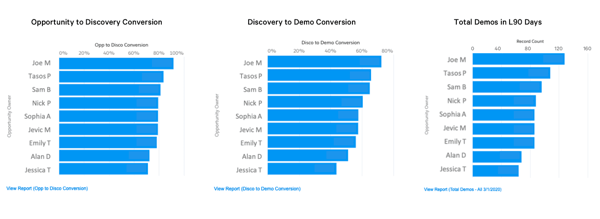Remember not long ago when we’d never heard of Dr. Anthony Fauci, had no idea what Zoombombing was, only occasionally worried about getting the flu? We came into 2020 like we do most years, with expectations grounded in habits and routines that we had no idea were about to dramatically change.
So here we sit, in month-six of a global health crisis and dealing with the extended requirement of working from home and keeping ourselves and our families healthy and safe. Oh, and we still need to get our jobs done! Keep customers happy, find new ones, and get back to growth. In other words, despite all that is swirling around us, we all still need to find a way to do our jobs just as efficiently as if nothing was going on in the world.
Despite being in an environment where so much of your day appears beyond your control, there are some significant pivots you and your marketing & sales teams can make to improve engagement, revenue, and retention.
Let’s dive into how you can level-up your team’s skills, motivation, and messaging while navigating a market shift.
Switch Up Your Messaging
In the early days of the pandemic, your first messaging and outreach pivot was likely awkward or apologetic; “In these difficult times”... “Hope you remain well…”, you get my drift. Some of you stopped prospecting altogether or dramatically scaled back to avoid potential negative repercussions. We’d never been in this situation before, so our first messaging pivot was to first be empathetic and then attempt to turn our message back to business.
Very quickly, however, another important pivot was required. Your prospects got settled down, got more comfortable with managing their new normal, and grew tired of the relentless emails and calls with watered-down empathy and well wishes. Your prospects and customers wanted to get back to business! Sure, you were talking to them in their living room with children laughing in the background, but back to business it was!
Rather than hearing empathy, your prospects want to know if you could help them get back to growth during the pandemic, help them ride the tailwinds the pandemic may have brought to their business, or in some way help them be more productive in the new “work from anywhere” world we’re in.
Another key pivot was that your sales teams might have tried to relate to current events by incorporating the pandemic’s new normal into outreach, “COVID-19 has exposed some key gaps in your strategy. Let’s discuss a solution.” Or for prospects that were fortunate enough to be positively impacted, “COVID-19 has put a significant tailwind on your business; let’s discuss how you can stay there.”
With any of your messaging pivots, one truth always holds true: Ultimately, when you're messaging to a prospect, regardless of whatever world craziness everyone is dealing with, you need to stay focused on the three elements of the value wedge.
- Speak to what’s important to your customer.
- Make sure your prospect knows that what you have is unique to you.
- You can defend your position – aka none of your competitors can make your same claim.

Whatever messaging pivot you may need to make, be sure to keep your effort grounded in your company's value wedge(s). Your prospects will appreciate you speaking to their business issues, that you are clearly showing how you differ from any other options available, and you can prove it. By doing so, you make their buying journey much easier. By following this methodology, your reps will speak to the desired outcomes that your product or service enables.
Instrument Your Business
100% of your business comes from somewhere. Do you know where? Now that we’re all working from someplace other than the office, it’s critical that you’ve instrumented your business to ensure that everyone knows what’s going on regarding lead follow-up, hustle stats, demos run, deals closed, win/loss analysis, etc. etc.… you get my idea.
Start with the Leading Indicators to success. What are they? How do you count them? How can you make each of them transparent to your entire organization? When it comes to your leading indicators to revenue, some aspects that you could focus on are listed below. Though, there are plenty more you can come up with.
- Total inbound leads and opportunities
- Opportunities created via outbound activity
- Discovery Calls Run
- Demos Run
- Contracts sent
- Closed Won/Lost
Now that you’re tracking the key leading indicators to success, make sure you’re tracking the relative conversion rates of each stage. How many leads convert to Discovery Calls? How many Discos result in a Demo? What’s your Demo to Close conversion? Where do you see gaps? Where can you improve?
Then “instrument” everything in your CRM, so it’s automatically updated and available for everyone to see. If your teams are kicking it on Demos, you’ll have a pretty solid idea of how many will convert to proposals and wins.

In addition to figuring out where you stand as a business, figure out how each member of your team is performing against your leading indicators. Your coaching opportunities and focus as a leader now becomes more fact-based vs. the old “I think, I feel” approach. Pinpoint areas of improvement for more refined training. Highlight high performers at each stage of the sales funnel and leverage those reps for training and mentoring.

Wellness Has Never Been More Important
At all times, even during normal working environments, work-life balance is critical to employee and company success. However, this final pivot is especially important when the market shift displaces your company from its normal location and daily routines.
A few months ago, we didn’t know how long things were going to last - working from home, everything going virtual, and losing a sense of a normal routine. When I left the office back in March, we initially thought “two weeks”! Now it’s more like “when in 2021 will we be back?”
A number of studies have indicated that nearly everyone on the planet is suffering from some level of anxiety, depression, or general unhappiness associated with this pandemic. And this isn’t even counting the unfortunate people who have actually contracted COVID-19. Living and working right now is hard – and it’s hard for everyone!
Take the time to show you care about every one of your employees. Check in on how their living arrangements are. How are they coping? Is there any way you can make their day to day a bit easier, more productive, and fun again?
We’ve done a few new things at Crayon to promote mental and physical health while we’re working from anywhere:
- A #wellness Slack channel. A place for employees to share helpful resources, tips, and engage in conversations around overall wellness. Plus, we have automated messages to remind us to take care of ourselves during the day to avoid burnout.
- Encourage New Routines: Working remotely changes the way we get ready for work. Our commute is walking over to our desk from the kitchen, we don’t have to get to the office at a specific time, and our workspace is also our living space. Making sure that everyone gets back to healthy routines is important. One move we made is to have a Sales Stand Up Zoom meeting every day at 8:30 am. Attendees need to be showered, dressed, and have their cameras on.
- Socially Distanced Meetings: We all miss our coworkers, and we all miss that face time we normally get in the office. If it’s possible in your area, set up socially distant meetings with your teams. We’ve held Sales Leadership meetings in my backyard. I’ve met with my CEO twice in his backyard. All safe and distant, but in person!
- Put Mental Health First: We can’t do our jobs successfully if we don’t take care of our mental health first. In addition to encouraging breaks, encourage days off, not sick days or vacation days, but mental health days. Encourage your employees to take the time to recharge so that they can come back ready to rock and roll.
Keep a sharp eye on your messaging. Be ready to adapt and adjust. Instrument your business for success. Be transparent with all your leading indicators to success. And, take care of your people – they are the most important asset you’ll ever have.

Related Blog Posts
Popular Posts
-
 How to Create a Competitive Matrix (Step-by-Step Guide With Examples + Free Templates)
How to Create a Competitive Matrix (Step-by-Step Guide With Examples + Free Templates)
-
 The 8 Free Market Research Tools and Resources You Need to Know
The 8 Free Market Research Tools and Resources You Need to Know
-
 Sales Battlecards 101: How to Help Your Sellers Leave the Competition In the Dust
Sales Battlecards 101: How to Help Your Sellers Leave the Competition In the Dust
-
 6 Competitive Advantage Examples From the Real World
6 Competitive Advantage Examples From the Real World
-
 How to Measure Product Launch Success: 12 KPIs You Should Be Tracking
How to Measure Product Launch Success: 12 KPIs You Should Be Tracking




.png?width=500&name=Sales%20Enablement-What%20is%20SE_%20(2).png)
